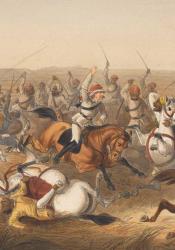The East Indian Rebellion of 1857
1857- The East Indian Rebellion was an uprising from Indian soldiers against the British rule that was taking place at the time. Long before the Gandhi movement, this revolution was extremely bloody in terms of engagement. Before going into the actual actions that occurred during this bloody period, we must first look at the beginning actions that lead to this moment in Indian history. British laws were becoming more taxing towards Indian citizens both economically and societally. What was more frustrating is that the British parliament weren’t the ones originally in control, but The East India Company instead.
The company slowly gained control over all of India from the originally Indian princes that had a majority of land under their rule. As they gained more power, the company began to employ private armies to help ‘safeguard’ the lands they acquired by force and money. These armies were made up of mostly Hindu and Muslim combatants, along with a few select British forces as well. The native soldiers, called sepoys, were better than British soldiers in every physical aspect, ranging from height to muscular build. Of course this wasn’t enough for the British soldiers, referring to the sepoys as their racial inferiors.
What was the turning point in these private armies began with a new rifle manufacturer that used beef and pork products to create the paper cartridge for the ammunition. Hindus do not believe in eating beef as it goes against their religion, as Muslims do not believe in eating pork for religious purposes as well. The British company, at first, tried to deny the usage of beef and pork products for the new cartridge. The reason this upset the Hindu and Muslim soldiers due to the fact that the cartridges, in the time period, were supposed to be bitten off to use in the rifles. This would mean an unwilling consumption of meat that is forbidden in both religions.
The sepoy were outraged at this attempted mockery towards their belief systems, since the racist belief that the British had about Muslims and Hindus were very known. The news spread across all the military forces in India, since this only affected the sepoy forces. As such, many attempted a mutiny against British rule. In turn, many of the punishments against sepoy forces were deemed too cruel and unjustified to continue without a proper response. Thus, the sepoy began to lead the revolution that disbanded the East Indian Company.
The conflict was met with extreme violence from both parties. Many people were killed in the ensuing bloodshed, with women and children also being a part of the casualties. While sepoys and bands of Indian citizens targeted anything British (people, land, buildings, etc.) in their violence, the British retaliated with their own mindless violence against random people. With tension growing rapidly, more violence besieged in most areas of India as the East Indian Company fought for control still. This effort was futile in the autumn of 1858, when the company was forced to disband all control of India to the British parliament. Even with this win, Great Britain still had an iron fist over the citizens of India until Gandhi began his non-violence teachings.

